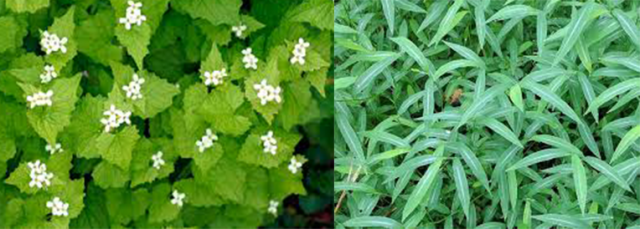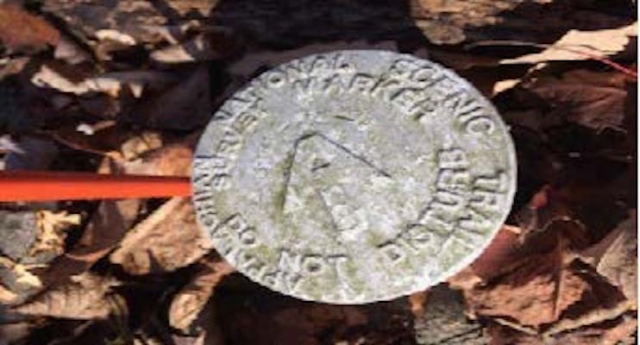

Posts Filtered by Tag - Trail Maintenance |
Show Recent Posts
August 22, 2022
Bake Oven Knob Grafitti Cleanup
Bake Oven Knob Grafitti Cleanup
Photos of the 2022 clean-up of graffiti at Bake Oven Knob give a sense of the scale of the effort and the cooperation required between agencies.

Before and after the clean-up

Fire crews pump water to the Knob

Drying the hoses before re-rolling them
Learn more about the ongoing effort to keep Bake Oven Knob graffiti-free here.

May 10, 2019
Spring Is Here, Invasive Species are Starting to Sprout
By Karen Gradel
Spring Is Here, Invasive Species are Starting to Sprout
By Karen Gradel
Spring is here, the air is warming up, the birds are chirping and the plants are starting to sprout. But not all the plants emerging along the trail are a good sight. We have invasive plants along our section of the Appalachian Trail.
So what exactly is an invasive species? Not every plant that is introduced to a new region is invasive. Orange and Banana trees are not native to the US but after being brought here they are not invasive. According to Executive Order 13112 in 1999 a species is considered to be invasive if it meets two criteria: (1) it is nonnative to the ecosystem under consideration, and (2) its introduction causes, or is likely to cause, economic or environmental harm or harm to human health.
AHC has been concentrating mainly on two invasive species, Garlic Mustard and Japanese Stilt Grass during it’s Trail Maintenance. Both choke out local species and can create dense populations in as short 5 year period. They can eliminate the rare plants living in our section of the trail, such as the Pink Lady Slipper that can been found in Spring along the trail near Fort Franklin Road. Garlic Mustard also impacts the West Virginia White Butterfly. The butterfly mistakes Garlic Mustard for it’s host plant and the offspring laid on it don’t survive. Removing the plants at the right time is also important because both Japanese Stilt Grass and Garlic Mustard seeds can remain viable in the ground for five or more years.

Garlic Mustard (left), Japanese Stilt Grass (right)
We have two maintenance hikes scheduled this quarter. One on April 13th at Lock 2 and the other on May 19th on the AT, where we will be continuing our battle with Garlic Mustard and other invasives. Don’t forget to take some Garlic Mustard home with you, because it’s edible. Check out this recipe for Garlic Mustard Pesto:
Garlic Mustard Pesto
Tip: Garlic Mustard is different from other greens in that the more mature plant leaves are less bitter than the young leaves, so try to use leaves from 2nd year plants of this Biennial.
Ingredients:
11 cups lightly packed garlic mustard leaves and tips, loosely chopped
1/4 cup pine nuts
1 garlic clove
1/3 cup grated parmesan cheese
1 cup extra virgin olive oil
1/2 teaspoon salt
1/2 teaspoon sugar
2 squeezes lemon juice
Directions:
In a blender, grind the garlic, pine nuts and parmesan. Add the garlic mustard. While blending, pour in a steady stream of the olive oil for 1 minutes, or until smooth. Add salt, sugar, lemon juice and pulse until mixed.
Also don’t forget to check out the revised AHC website. There’s easier navigation to documents. The calendar is improved with more functions and a quicker way to view past hikes. Thanks to Web Master Hal Wright for all the work he’s done updating our website to make it more functional and easier to explore all of our upcoming events.

February 19, 2019
Corridor Monitoring - What It Is and Why We Do It
by Lucy Cantwell
Corridor Monitoring - What It Is and Why We Do It
by Lucy Cantwell
Walking the boundaries of Appalachian Trail lands to prevent encroachments is an essential part of our responsibilities as a maintaining club.
It's the time of year for the Allentown Hiking Club to do our annual corridor monitoring. We talk about it a each meeting, but some of you may wonder, "What is this all about?" Here is a brief explanation of this annual activity.
A critical component of our duties as a maintaining club of the AT is corridor monitoring and boundary maintenance: keeping a close eye on the federal estate purchased to protect the Appalachian Trail. The AT "corridor" is the land owned by the National Park Service that extends a few hundred feet on either side of the trail. Corridor monitoring means walking along and examining the border of this NPS land and the adjacent lands ( for example, privately owned lands, state game lands, municipalities) to assure that all boundary markers are in place and no encroachments have occurred. This involves leaving the AT treadway and bushwhacking over rocks and through dense vegetation to locate "monuments," i.e., the markers installed by surveyors years ago to establish a line between NPS lands and that of neighboring landowners.

Encroachments, such as illegal dumping of waste, timber theft, rock piles, discarded machinery, hunting blinds, or evidence of incompatible uses such as ATVs are also documented. These discoveries are subsequently reported to the ATC (Appalachian Trail Conservancy) and corrective action is taken, if needed. During the monitoring we also post signage along the boundary lines, indicating which areas belong to the NPS. Volunteer monitors thus become the “eyes and ears” of state and federal landowning agencies. Monitoring helps assure the American public that its investment is being cared for and protected.
The Allentown Hiking Club monitors 35 tracts containing over 600 acres, which has 106 surveyor's monuments and 15 1/3 miles of exterior boundary. This is divided into 7 sections and is monitored by club members who commit to individual segments of about 4-7 miles each. Some of our monitors have been doing their sections for upwards of 20 years!
New volunteers are always welcome and encouraged to step up and join the action! If you think you might be interested in participating in the corridor monitoring, please contact the Monitor Coordinators listed on page 2 of the newsletter. We'd be happy to have you join one of the established monitors when they hike their section to collect the monitoring information. Also, keep an eye out for announcements on the AHC Forum, as monitors may post their hikes on the spur-of-the-moment, since good weather conditions are generally better for this activity. Be adventurous and come and see what it's all about!

POSTS BY TAG
POSTS BY MONTH